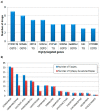Systematic Approach for Drug Repositioning of Anti-Epileptic Drugs
- PMID: 31801232
- PMCID: PMC6963462
- DOI: 10.3390/diagnostics9040208
Systematic Approach for Drug Repositioning of Anti-Epileptic Drugs
Abstract
Epilepsy is a central neurological disorder affecting individuals of all ages and causing unpredictable seizures. In spite of the improved efficacy of new antiepileptic drugs and novel therapy, there are still approximately 20%~30% of patients, who have either intractable or uncontrolled seizures. The epilepsy drug-target network (EDT) is constructed and successfully demonstrates the characteristics and efficacy of popularly used AEDs through the identification of causative genes for 60 epilepsy patients. We discovered that the causative genes of most intractable patients were not the targets of existing AEDs, as well as being very far from the etiological mechanisms of existing AEDs in the functional networks. We show that the existence of new drugs that target the causative genes of intractable epilepsy patients, which will be potential candidates for refractory epilepsy patients. Our systematic approach demonstrates a new possibility for drug repositioning through the combination of the drug-target and functional networks.
Keywords: NGS; drug repositioning; drug-target network; epilepsy; precise medicine.
Conflict of interest statement
The authors declare that they have no conflict of interest.
Figures




References
LinkOut - more resources
Full Text Sources

